2007 Ford Explorer
Sport Trac
Evolution of the Sport Utility
Truck
Article by Jeff Steinwand
Evolution is intriguing. Sometimes kooky-looking creatures
thrive, while other seemingly well-adapted ones perish. Species are
shaped through generations of continual refinement. Those inheriting
the beneficial traits will prevail because of their ability to
survive. This theory applies to more than just the animal kingdom; the
automobile industry is subject to the same principles as nature.
When it was first introduced five years ago, the Explorer Sport Trac was
unique in appearance. It aimed to possess a wonderful combination
of genes: the comfort and convince of a sport utility, along with a
practical cargo area, a standard truck bed in condensed form.
In 2000, it seemed to be a viable alternative to a 3/4-ton crew
cab, which were growing in popularity, but rather impractical to use as a family vehicle.
In some ways the Sport Trac was ahead of its time. It was hurriedly
created to fit an emerging market in an effort to dominate the
competition, but it ended up with some less than desirable
traits. The Sport Trac was afflicted by the outdated chassis of the
Explorer on which it was based. The basic design spanned more than decade, and it soon began
to show its age. The comfort-tuned suspension was sloppy, and the solid rear axle
ride provided a jarring ride that was less than desirable for carrying
a load of human cargo.
As more things changed in SUV territory, the Sport Trac remained the same.
It did not receive an overhaul when the 2002 Explorer was given a
complete update, so it lacked the independent rear suspension that
almost every other SUV on the road has today. The niche market the
Sport Trac served was attacked by predators of all shapes and sizes,
and its niche market dwindled.
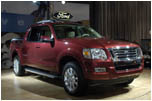
Sport Track Unveiling |
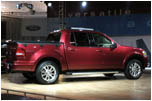
Texas State Fair |
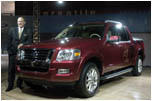
Al Giombetti Posing |
While previous generation of Sport Trac ceased
production in June 2005, the Sport Trac has survived. Just this week, Ford revealed the
next generation 2007 Sport Trac at the Texas State Fair. The
half-truck half-SUV has been reborn with a fresh new look, pulling many
styling cues from the 2005 Adrenaline concept. It lacks the
ground-hugging stance and vented fenders of the street-inspired
concept vehicle, but otherwise the new Sport Trac follows the concept very closely. The
next generation sport utility truck also is more massive in appearance and larger in size, two inches wider and five inches longer than the previous
version.
The 2007 model is now based on the modern Explorer
chassis. From the front doors forward, the Spot Trac is identical to
the 2006 Ford Explorer. This includes the massive chrome grill,
which extends from the hood to the lower fascia, and compound headlamps
with integral turn signal lamps. The rear doors have been altered to
accommodate the xenografted truck bed.
The bed design is distinctly more truck-like than before, taking
influence from the current F150. If approached from behind, one could
mistake the Sport Trac for its full-size cousin, but the cargo area
has been shortened to just 4 1/2 feet. The bed is
molded from a plastic composite. Its exterior is painted like the rest
of the body, and the inside receives a dent-proof liner. As with the
previous generation, this cargo box features exterior anchor points,
but now has added notches in the plastic liner to
accommodate 2X4s as crossbars so that a standard 4x8 sheet of plywood
will fit horizontally on top of the wheel arches.
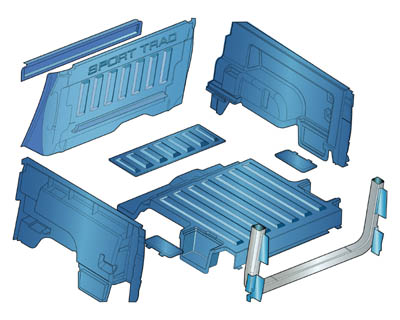
At the base of the cargo area you will find utility bins beneath
the bed floor. Small boxes are located in the area just behind the
wheel wells, one per side, just large enough to hold a six-pack of
your favorite beverage. One large box is located at the front of the
bed, spanning its width. All three boxes are weather-resistant and
include drain a plug so to accommodate ice to keep your beverages
cold.
Inside, the Sport Trac gets a rugged rubber floor covering with the
ability to handle any mud or grease you may throw at it. Berber-carpeted floor mats
provide comfort, along with a leather option, which gives all five
occupants two-tone seating surfaces. Heat and 10-way power
adjustments as also options for the front seats.
Various innovations include a heated windshield to eschew snow and
ice, ergonomic interior door handles, and a console-mounted gear
selector similar to the one found in the F150.
More excitement can be found under the hood, where a standard
4.0-liter V6 engine resides. Providing 210 horsepower at 5,100 rpm and
254 pound-feet of torque at 3,700 rpm, this engine is mated to a
standard 5-speed automatic transmission. The engine uses advanced
technology to reduce tailpipe emissions to the same level as the Ford
Escape Hybrid. Upgrade to the 4.6-liter V8 with
6-speed automatic and you can reap the benefits of 292 horsepower and
gain the ability to tow 6,800 pounds. This engine is expected to
break the 20-mile per gallon mark in highway cruising.
You can put that power to the ground with the optional Control Trac
four-wheel-drive system. If the rear wheels lose traction, the system
will automatically divert power to the front wheels.
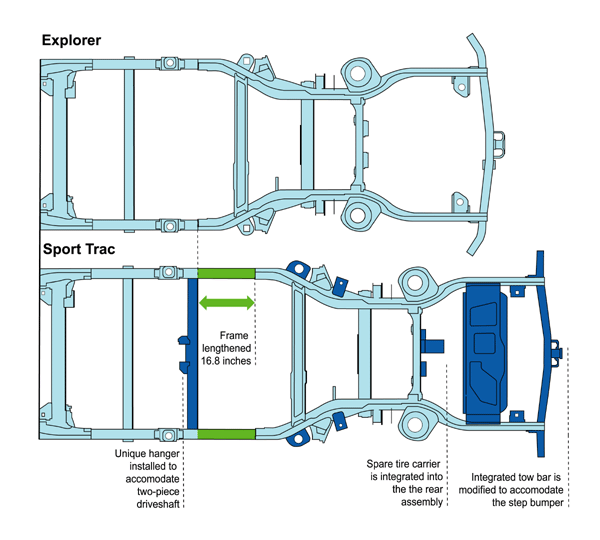
The Sport Trac inherits the "tube-through-tube" frame design from the
F150. Frame cross members pass through the main frame rails to provide
a chassis that is 444 percent stiffer than the previous model.
The frame is also used on the 2006 Explorer, although the wheelbase has
been stretched 16.8 inches on the Sport Trac, and a two-piece driveshaft has been added.
The front suspension features a short- and long-arm design with
coil-over shocks, tuned for damping harsh impacts while providing
body control over larger irregularities and when cornering.
The rear suspension uses an independent design, the same trailing blade
design found on the 2006 Explorer. The Sport Tracís rear
coil-over springs, monotube shocks, and stabilizer bar have slightly
stiffer rates than those found on the Explorer to accommodate the
longer wheelbase. The result is a ride that should be light years
ahead of its predecessor in terms of comfort as well as handling.
Four-wheel disc brakes are standard, as is an anti-lock braking
system. The Sport Trac also offers the AdvanceTrac Safety System with
Roll Stability Control, as found on the 2006 Explorer. Other safety
enhancements include side-curtain airbags for all passengers, and
side-impact airbags for front occupants.
Ford will build the new Sport Trac at the Louisville Assembly Plant
starting in spring 2006, offering it as a 2007 model. Many enthusiasts are
excited about the new Sport Trac, and with good reason. The new model
is better is almost every aspect, and comes much closer to an ideal
cross between a comfortable SUV and a practical truck. If there is any
room left in the grey area between truck and SUV, this vehicle will
surely occupy it. The question is, is there enough room?
|